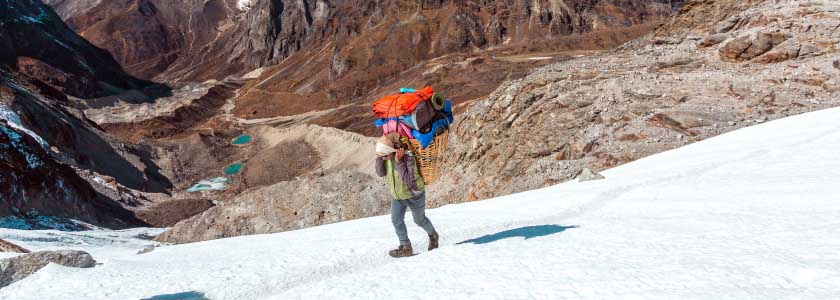From the Himalayas to the deep sea, how do some people adapt to adversity?

How is it that some groups of people can live, even thrive, at elevations so lofty most normal humans are incapacitated—or even die? And how is it that some humans can dive so deliriously deep into the ocean they earn the nickname “sea nomads?”
The answer is simple: genetics.
Many Tibetans and Nepalis live and work daily at elevations in excess of 15,000 feet above sea level, where the effective oxygen rate is just 12%, or less than half of what it is at sea level.
For reference, most humans start to feel significant effects from altitudes at less than 7,000 feet above sea level, with common problems being headaches, fatigue, loss of breath, dizziness, loss of appetite, and difficulty sleeping. More serious complications, sometimes experienced at elevations as low as 4,900 feet above sea level, include high-altitude pulmonary edema, where increased pressure causes the lungs to fill with fluid.
Tibetans, however, do relatively well at high altitudes due in part to genes they inherited from ancient humans.
As reported in Science, Tibetans inherited a gene variant from the people known as Denisovans, a human race that went extinct after mating with modern humans some 40,000 years ago.
Other people who live at high altitudes, such as those in the Andes of South America, adapted by adding more oxygen-carrying hemoglobin to their blood. Tibetans, however, have less hemoglobin, and this may help them avoid altitude-associated problems, such as clots.
(Although a 2017 study found that Andeans had gene changes in EDNRB and SENP1 that aid in cardiac tolerance and polycythemic response, respectively, and a 2019 study found evidence of positive selection for these traits.)
A 2010 study found that Tibetans have an alternative form of the gene EPAS1, which improves hemoglobin regulation. As noted by Science, Tibetan DNA sequences match with those of Denisovans.
“The team also compared the full EPAS1 gene between populations around the world and confirmed that the Tibetans’ inherited the entire gene from Denisovans in the past 40,000 years or so—or from an even earlier ancestor that carried that DNA and passed it on to both Denisovans and modern humans,” noted Science.
Denisovans are thought to have primarily lived in Siberia—which is not particularly close to Tibet. The missing link may have been Tibetans’ ties to Han Chinese. For the Melanesians in Papua New Guinea, Denisovan DNA makes up about 5% of their genome.
But what about the other end of the spectrum— how long can Bajau hold their breath deep-sea free diving?
That’s the specialty of the Bajua Laut people of Southeast Asia, mainly the Philippines, Malaysia, and Indonesia, one of whom set a free-diving record of 259 feet; another reported spending 13 minutes underwater. Some "sea nomads" spend more than five hours a day submerged, hunting for fish, octopus, clams, sea cucumbers, and other seafood without diving gear, save a swimsuit and a pair of wooden goggles. Most live in small villages completely attuned to the cycles of the ocean.
According to a study in Cell, the Bajua Laut have spleens 50% larger than average, and that likely makes the difference.
The spleen has a reservoir of oxygenated blood cells, and when people dive, it contracts, and the cells are released into the bloodstream.
In the Cell study, researchers measured the spleens of 59 Bajua using portable ultrasound, then compared the results to those of unrelated people living nearby who were not deep divers. They then backed up the study with mouth swabs to collect DNA and found a mutation in the Bajuas’ PDE10A gene, which may increase spleen size.
Other genes of interest include BDKRB2, which is involved in diving response, and FAM178B, which helps maintain blood pH during carbon dioxide accumulation.
Things are changing for the Bajua Laut, notes National Public Radio. The lightweight wood they used for boats has become scarce, meaning boats are made from heavier wood, which results in boats that need engines and fuel, all of which point toward an end of their nomadic, sea-based lifestyles. If they stop diving, will this unique genetic trait disappear? No—at least not for now.
"If the Bajau population stops diving completely but nothing else changes, they will keep their big spleens for an indefinite amount of time," said Melissa Ilardo, a doctoral student at the University of Copenhagen who studied the Bajau. "There is no force of natural selection acting to 'undo' the big spleen adaptation."


 Processing
Processing
